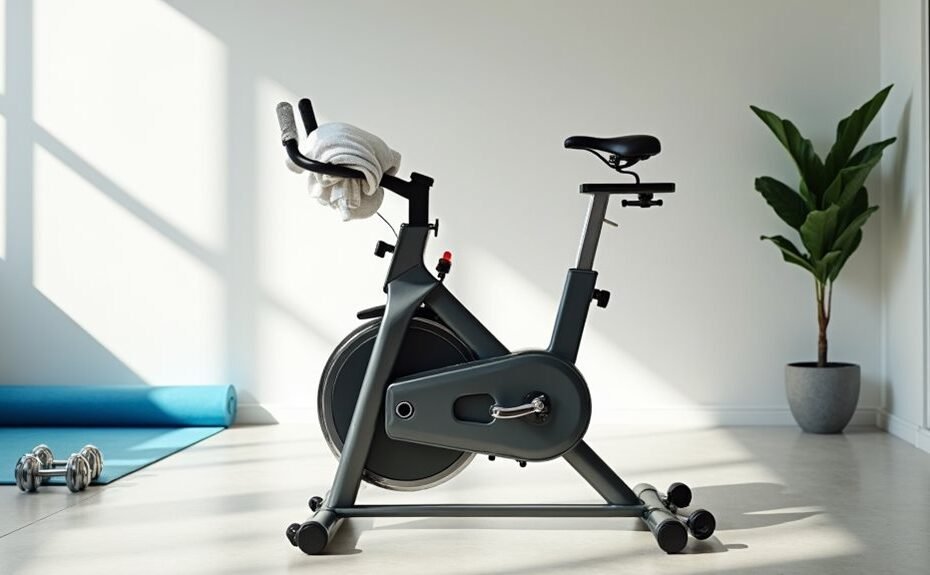I've found that stationary bike workouts can transform your weight loss journey, but only when you know exactly how to use them. As a fitness enthusiast who's helped countless people shed unwanted pounds, I can tell you that most cyclists make critical mistakes that limit their results. While it's true that any movement is better than none, there's a specific combination of intensity levels and training styles that can double or even triple your fat-burning potential. Let me share the proven method that's helped my clients achieve remarkable results on their weight loss journey.
Key Takeaways
- Alternate between 30-second high-intensity sprints and 60-second recovery periods for optimal fat burning during 30-minute sessions.
- Maintain 150 minutes of weekly cycling spread across 3-5 sessions, gradually increasing duration and resistance as fitness improves.
- Combine seated and standing positions during workouts to engage more muscle groups and maximize calorie burn.
- Incorporate both HIIT and LISS workouts throughout the week, with HIIT burning more calories and LISS building endurance.
- Track workout metrics and maintain consistent progression while aiming for a sustainable weight loss of 0.5kg per week.
Why Stationary Bikes Work
Featuring both cardiovascular and strength-training benefits, stationary bikes offer an effective workout solution for weight loss goals. I can tell you that these machines are particularly effective because they create the caloric deficit you need for shedding pounds while protecting your joints from excessive stress.
You'll burn between 210-294 calories in just a 30-minute moderate session, and if you're up for high-intensity work, you can torch more than 600 calories per hour. I recommend incorporating interval training to maximize your caloric burn in less time, which is perfect if you're busy but committed to weight loss. Those with chronic pain or injuries can especially benefit from stationary bikes as a safe exercise option.
What makes stationary bikes especially practical is their low-impact nature. You'll strengthen your lower body muscles, including your calves, hamstrings, and quadriceps, while also engaging your core and back muscles – all without putting harmful stress on your joints. Studies show that regular cycling can help improve sleep quality, making it easier to maintain a healthy weight.
As you pedal, you're also improving your cardiovascular fitness, enhancing blood flow, and reducing risk factors for heart disease. This combination of muscle strengthening and cardio benefits makes stationary bikes an ideal choice for sustainable weight loss.
Understanding Your Weight Loss Goals
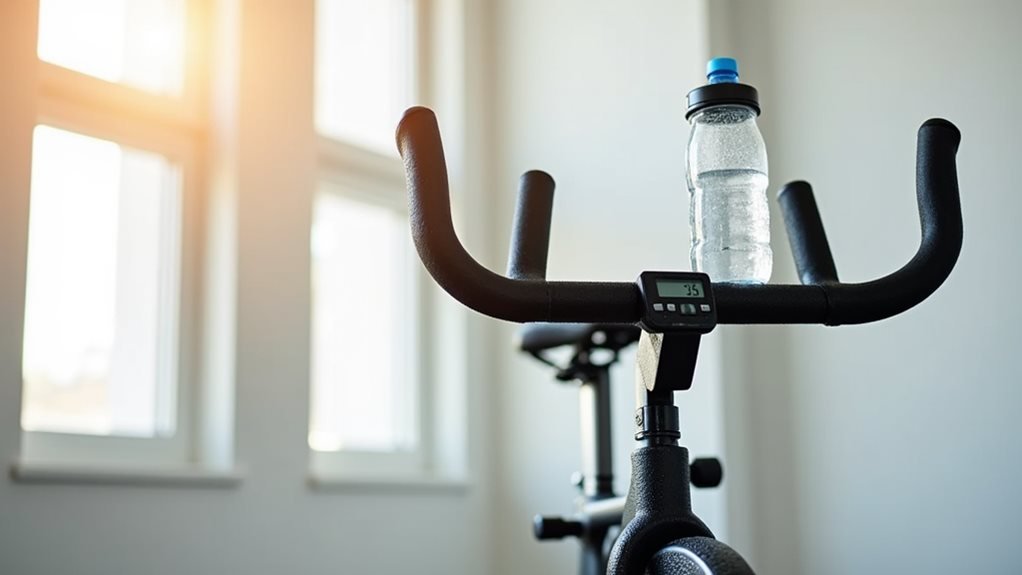
Now that you understand how stationary bikes can aid in weight loss, let's focus on setting your personal goals. I recommend starting with a realistic assessment of where you're and where you want to be. If you're new to cycling, begin with 10-15 minute sessions and gradually work up to the recommended 150 minutes per week.
Your weight and workout intensity will determine how many calories you'll burn. For example, if you weigh 155 pounds, you can expect to burn between 260-298 calories in a 30-minute moderate session. Increasing your workout intensity with different resistance levels can help maximize your calorie burn. It's important to aim for gradual weight loss of about 0.5kg per week. By tracking your workouts and nutrition, you'll make sure you're maintaining the caloric deficit needed for weight loss.
I can't stress enough that exercise alone won't get you to your goals. You'll need to combine your cycling routine with proper nutrition to create sustainable results. Consider working with a fitness professional to develop a personalized plan that includes both exercise and dietary guidelines.
Remember to set specific, measurable goals – whether that's losing a certain amount of weight, building endurance, or increasing muscle mass – and track your progress regularly to stay motivated and on course.
Essential Equipment and Setup
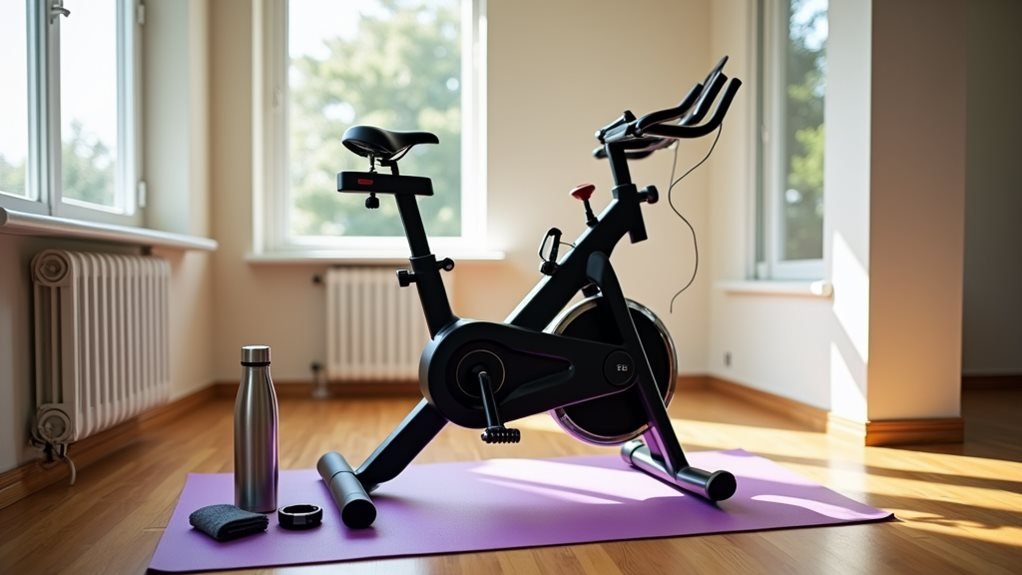
A stationary bike's effectiveness relies on selecting the appropriate equipment and creating an optimal workout environment. I recommend starting with either an upright bike for a traditional cycling experience or a recumbent bike if you need extra back support. Look for models with adjustable resistance and pre-set programs to keep your workouts varied and challenging. Breaking up workouts into shorter sessions throughout the day can make your routine more manageable.
When setting up your workout space, I've found that proper positioning is vital. Place your bike in a well-ventilated area with enough room to mount and dismount safely. If you're working with limited space, consider a foldable model that you can store away when not in use. Since stationary bikes are low-impact on joints, they're an excellent choice for users of all fitness levels.
Make sure your bike includes essential tracking features like calorie burn monitoring and speed settings. These tools will help you measure progress toward your weight loss goals.
I suggest positioning entertainment options within easy reach – whether it's your tablet, TV, or music system – as they'll help you stay motivated during longer sessions. Don't forget to keep a water bottle nearby and regularly check your bike's maintenance needs to maintain safe, effective workouts.
Perfect HIIT Cycling Program
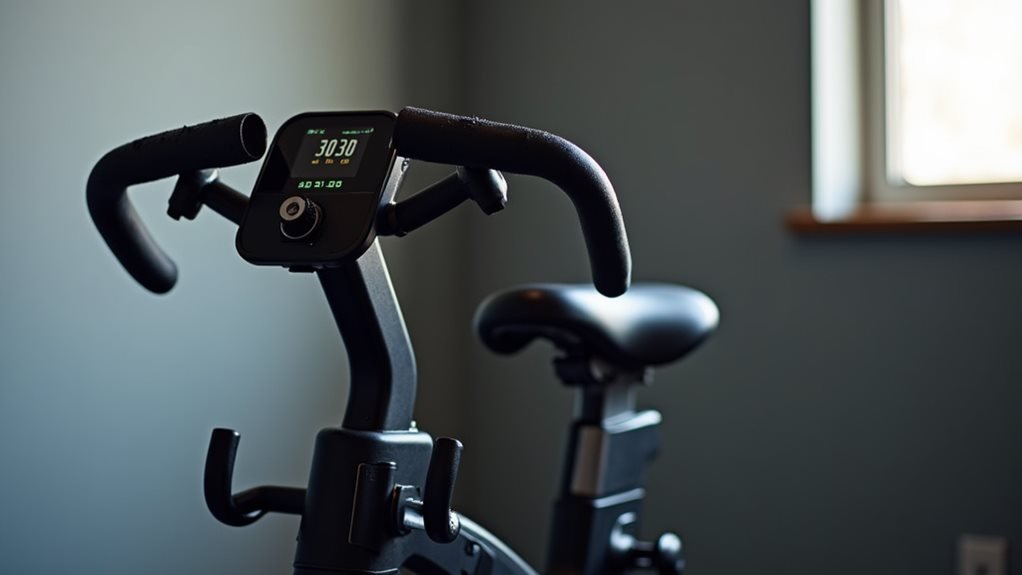
With your bike properly set up, let's maximize its fat-burning potential through High-Intensity Interval Training (HIIT). I'll show you how to structure your workouts to burn more calories in less time while boosting your metabolism for hours afterward.
Start with a 5-minute warm-up at a gentle pace. Then, I recommend beginning with this simple but effective pattern: pedal at high resistance for 15 seconds, followed by 1 minute and 15 seconds of low-resistance recovery. Repeat this cycle for 10 minutes, then gradually increase your workout duration to 20-30 minutes as your fitness improves. This workout format delivers more results than steady-state cardio in significantly less time. Always ensure you maintain proper bike maintenance to get the most effective workout possible.
To keep challenging yourself, I suggest alternating between different HIIT patterns. You can try 30 seconds hard/30 seconds easy, or 20 seconds intense/10 seconds recovery. The key is to push yourself to 80-95% of your maximum effort during high-intensity intervals. During recovery periods, keep pedaling at a slower pace to maintain momentum.
Remember to cool down with 5 minutes of easy cycling. For best results, I recommend combining these HIIT sessions with a balanced diet and performing them 3-4 times per week.
Tracking Progress and Results
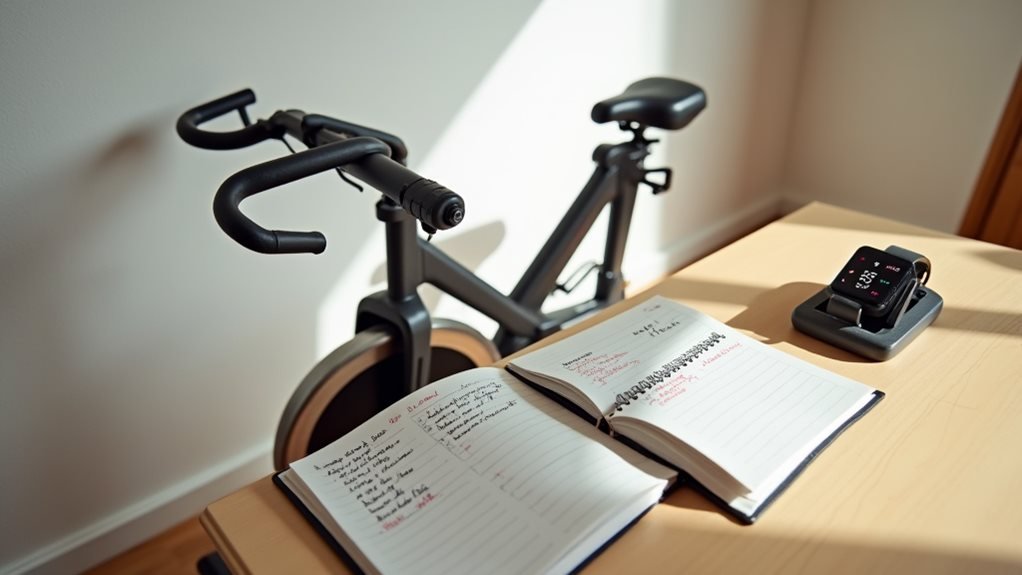
Tracking progress on your stationary bike journey helps maintain motivation and guarantees you're moving toward your weight loss goals. I recommend starting by setting clear, achievable targets for both weight loss and exercise duration, aiming for at least 150 minutes of cycling per week.
To monitor your progress effectively, I suggest using cycling apps like Zwift or Peloton to track your workouts. Record your calorie burn, which can range from 210-495 calories per session depending on your weight and intensity level. Keep a workout journal to log your sessions, including duration, resistance levels, and perceived effort. High-intensity intervals can help you achieve better results in less time.
Don't just focus on the numbers on your scale. I want you to track multiple indicators of progress, including improvements in your cardiovascular fitness, sleep quality, and mood. Pay attention to changes in muscle definition, particularly in your legs, and note any improvements in joint mobility.
If you're new to cycling, start with shorter 10-15 minute sessions and gradually increase your workout time. Remember to consult with fitness professionals to create a personalized plan that aligns with your specific goals and needs.
Common Mistakes to Avoid
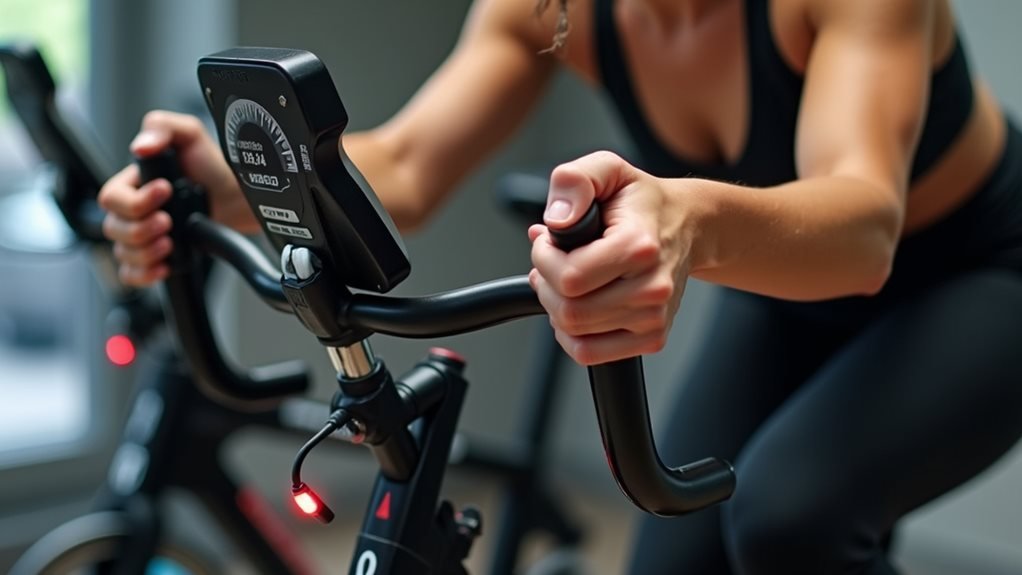
Now that you're equipped to track your progress, let's examine common mistakes that could derail your weight loss journey.
I've noticed many people struggle with maintaining consistency in their workout routine, which can greatly impact results. If you're skipping sessions or not varying intensity levels, you're limiting your potential for success. Starting with shorter workout sessions and gradually building up intensity is the smartest approach for long-term success.
One of the biggest pitfalls I see is poor nutrition habits. Remember, you can't out-exercise a bad diet. If you're consuming more calories than you're burning, even the most rigorous bike sessions won't lead to weight loss. I always emphasize the importance of staying hydrated and maintaining a balanced diet alongside your workout routine.
When it comes to using the stationary bike, proper form is essential. I recommend adjusting the resistance according to your fitness level and incorporating both seated and standing positions to engage different muscle groups. Don't forget to warm up and cool down properly to prevent injury.
Never start an intensive exercise program without medical clearance, especially if you have underlying health conditions. Listen to your body, and don't ignore signs of overexertion or fatigue.
Maximizing Calorie Burn

Maximizing your calorie burn on a stationary bike requires a strategic combination of HIIT and LISS workouts. I recommend incorporating both types into your weekly routine, as they each offer unique benefits for weight loss.
For HIIT sessions, I suggest starting with 10-20 minute workouts where you'll alternate between intense 30-second sprints and brief recovery periods. To boost your calorie burn even further, I'll show you how to adjust your workout intensity. Try standing up during high-intensity intervals and increasing your resistance levels. This won't just burn more calories – it'll also strengthen your lower body muscles.
During LISS sessions, maintain a moderate pace for 30-60 minutes, which can significantly contribute to your daily caloric burn.
Building A Long-Term Routine
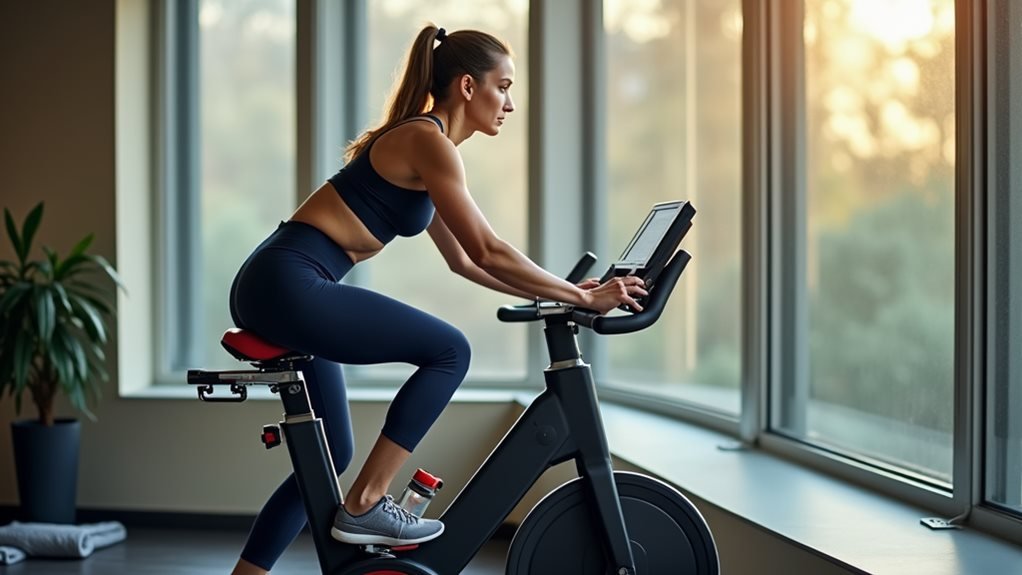
Building a sustainable stationary bike routine requires three key elements: consistency, progression, and variety. I suggest starting with 3-5 weekly sessions of 30 minutes each, gradually increasing duration as your fitness improves. To maintain motivation, I recommend mixing LISS and HIIT workouts throughout the week.
To ensure steady progress, begin with shorter 5-10 minute sessions if you're new to cycling. Always include proper warm-up and cool-down periods, and gradually increase resistance as your strength builds. I've found that tracking workouts helps you stay accountable and adjust your routine based on results.
For ideal long-term success, I recommend incorporating different workout types into your schedule. Try steady-state cardio sessions, high-intensity intervals, and even spin classes to keep things interesting. If you're short on time, break your workouts into smaller chunks or use the bike as a warm-up for other exercises.
To stay committed, consider joining group classes for added motivation. Focus on maintaining proper form throughout your workouts, and remember to celebrate both weight loss and broader health improvements as you progress.
Frequently Asked Questions
How Long Does It Take to See Weight Loss Results From Stationary Cycling?
I'll tell you that with consistent cycling and proper diet, you'll typically see initial weight loss within 4-6 weeks, though results vary based on your current fitness level.
Can I Use a Stationary Bike if I Have Chronic Knee Pain?
Like a gentle carriage ride, I'd highly recommend a stationary bike for your knee pain. It's low-impact, and you can easily adjust resistance levels to match your comfort while strengthening joints.
Should I Eat Before or After My Stationary Bike Workout?
I recommend eating a light snack 1-2 hours before your workout and having a balanced meal within 30-60 minutes after. This helps maintain energy and supports muscle recovery.
Is It Normal for My Seat to Hurt When First Starting Cycling?
Just like breaking in new shoes, seat discomfort is completely normal when starting cycling. I'll assure you that your body will adapt within a few weeks of consistent riding.
How Many Calories Do I Burn if I Can't Maintain High Intensity?
I recommend starting with moderate intensity, where you'll burn around 210-294 calories per 30 minutes, depending on your weight. It's sustainable and effective for consistent calorie burning.
